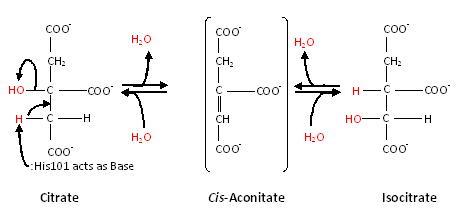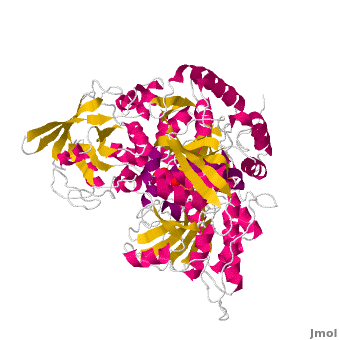Function
Aconitase (ACO, EC number 4.2.1.3) is an enzymatic domain that confers the ability to catalyse the equilibrium
- citrate = aconitate + H2O = L-isocitrate
This reaction is part of the citrate (TCA-, Krebs-)cycle.
In most organisms, there is a cytosolic enzyme with an ACO domain (cAc), and in eukaryotes, a second copy of it was introduced with mitochondria (mAc). Plants developed even more copies in mitochondria.
Aconitase contains a Fe4S4 cluster which converts to Fe3S4 when the enzyme is inactive. In humans, two types of ACO are expressed: the soluble ACO1 and the mitochondrial ACO2. Two types of ACO X were characterized as mevalonate 5-phosphate dehydratase and cis-3-hydroxy-L-proline dehydrates.
Aconitase from pig (PDB 7acn) is a single polypeptide (Mr 83kD) that catalyzes the reversible isomerization of citrate and isocitrate.[1] It is the second enzyme in the Citric acid cycle, which is a series of enzyme-catalysed chemical reactions that is crucial to aerobic cellular respiration and the production of ATP. See also:
Structure
The consists of numerous alternating alpha helices and beta sheets (SCOP classification α/β alternating). The tertiary structure is somewhat bilobed with the active site in the middle, and, since there is only one subunit, there is no quaternary structure. Aconitase consists of four domains, three of which are tightly packed while the fourth is more flexible. [2] Aconitase contains a . This iron sulfur cluster does not participate in redox as most do, but holds the OH group of citrate to facilitate its elimination.[3] It is at this 4Fe-4S site that catalysis occurs and citrate or is bound. The rest of the is made up of residues Gln72, Asp100, His101, Asp165, Ser166, His167, His147, Glu262, Asn258, Cys358, Cys421, Cys424, Cys358, Cys421, Asn446, Arg447, Arg452, Asp568, Ser642, Ser643, Arg644, Arg580. [4]
Catalytic mechanism of mitochondrial ACO
Both mAc and cAc are quite similar in their ACO function. Studies, however, concentrated on . ACO is an excellent system for understanding the role of iron-sulfur-clusters in catalysis. The by three sulfur atoms belonging to the cysteins-385, -448, and -451 cluster iron atoms. On activation of the enzyme, together with a water molecule.This Fe4 is free to bind one, two, or three partners, in this reaction always oxygen atoms belonging to other molecules.[5]
Substrate-free aconitase contains a [4Fe-4S]2+ cluster with hydroxyl bound to one of the Fe. Upon binding of substrate the bound hydroxyl is protonated. A hydrogen bond from to the isocitrate hydroxyl is donated to form water. Alternatively, the proton could be donated by as this histidine is hydrogen bonded to a H2O molecule. His167 is also hydrogen bonded to the bound H2O in the [4Fe-4S] cluster. Both are paired with carboxylates (, respectively) and are likely to be protonated. The conformational change associated with substrate binding reorients the cluster. [4] The residue which removes a proton from citrate or isocitrate is . [4] This causes the cis-Aconitate intermediate (seen below), which consists of a double bond, which is a direct result of the deprotonation. Then, there is a rehydration of the double bond of cis-aconitate to form isocitrate (if the original substrate was citrate). To better understand this, consider this process as stages, seen below.
Stage 1: Dehydration
First, dehydration of citrate causes a proton and OH group to be removed from only the 'lower arm'.[6] This forms a cis-Aconitate intermediate.
Stage 2: Rehydration
The second main stage of the reaction is the rehydration of the cis-Aconitate intermediate. This forms isocitrate. It is catalyzed in a stereospecific way such that only one isocitrate stereoisomer is formed. [6]
Thus, the overall reaction that aconitase catalyzes is: Citrate ←→cis-Aconitate←→Isocitrate, as seen below:

A more stereochemical view at the reaction shows that the aconitate intermediate has to make a 180 degree flip in order to start the other half of the reaction:

Regulation
Aconitase can be inhibited or activated to increase or decrease the ability to catalyze the reaction of citrate to isocitrate. The activity of aconitase can be reduced when one Fe is lost from the cluster. This lowers the activity over 100-fold, but then can regain full activity by adding another Fe from solution. [7] Aconitase is also strongly inhibited by nitro analogs [7]
The Citric Acid Cycle works in such a way that the product of one reaction becomes the reactant of another, with different enzymes catalyzing each reaction. Aconitase is one such enzyme. Some of these enzymes are tightly regulated, either activated or inhibited, by the concentration of reactant, product, ATP or NADH, and thus are rate-determining. Aconitase is not one of the three rate-determining enzymes of the Citric Acid Cycle as its ΔG is not negative (ΔG°′≈5 kJ/mol and ΔG≈0 kJ/mol).[6] Aconitase functions close to equilibrium and the rate of citrate consumption depends on the activity of NAD+-dependent isocitrate dehydrogenase, which is one of the three rate-determining enyzmes. Isocitrate dehydrogenase uses the product of the reaction aconitase catalyzes. Both Citrate synthase and Isocitrate dehydogenase are inhibited by NADH concentration, but aconitase itself is not.[6] Since the rate of aconitase depends on the activity of NAD+-dependent isocitrate dehydrogenase, then citrate could build up on the reactant side, which would then inhibit the enzyme of the previous step, citrate synthase. An illustration of this is seen below, with the boxes representing the enzymes that are catalyzing each reaction. This is a common example of how the Citric Acid Cycle works in order to produce ATP without wasting resources. Similar inhibition/activation of enzymes occurs based on concentrations of ATP, NADH, Calcium, CoA, and others.
Cytosolic aconitase and its other function
A specialty of cAc is that in mammals it has developed a as inhibitor of that carry an . Therefore, the cytosolic cAc is named IREBP for IRE-binding protein when this function is talked about. Only one of the two functions is active, depending on whether is present in the molecule: it's essential for . You can see, by , how much the enzyme structure differs between those two functions.
Along with serving as a catalyst, aconitase is a member of the iron regulatory protien-1 (IRP-1) family. These enzymes have been found to play a role in regulatory RNA-binding proteins. This suggests a novel role for Fe-S clusters as post-translational regulatory switches.[2]
3D structures of Aconitase
Aconitase 3D structures




